
PDF Publication Title:
Text from PDF Page: 025
able if it held only when underlying levels of criminality were also dis- proportionate. But the figure shows that this subpopulation-specific divergent behavior can still hold when the underlying subpopulation- specific crime rates are the same. This has the effect of increasingly criminalizing specific subpopulations and (more critically) generating more “objective” data to support future biased enforcement decisions. The algorithm described is more than just an illustrative tool. It also simulates the effect of inequitable and unprincipled state surveil- lance based on historic records. The simulation makes the argument that increased state surveillance is not a neutral tool, especially if it is not uniformly applied. On a populationwide-level, it can lead to ineq- uitable criminalization, in which criminals with different demographic characteristics have systematically different likelihoods of apprehen- sion and different sentencing intensities. The recent “color of surveil- lance” movement makes the argument that state surveillance in the United States has not been equitably applied. Some legal scholars argue that inequitable criminalization is the norm in the United States, often justified based on historical records of crime, as the COMPAS system was. The U.S. Department of Justice (2016) found more evidence of such inequitable surveillance and criminalization in its recent investi- gation of the Baltimore Police Department. A similar algorithm could be applied to the problem of finding fruitful mining or oil-drilling sites. Such an algorithm’s “inequitable” behavior—giving more attention to areas with a historical record of producing oil—may count as a feature (more focused attention and resources applied productively) and not a bug in that context. Part of the difference is that solutions to questions of public policy often need to account for other measures of quality informed by (sometimes fuzzy or inexact) social principles, such as equity or fairness. In this case, we expect law enforcement to be fair in the sense that enforcement activity should be proportional to criminal activity across categories. Algorithms: Definition and Evaluation 15PDF Image | Intelligence in Our Image Risks of Bias and Errors in Artificial Intelligence

PDF Search Title:
Intelligence in Our Image Risks of Bias and Errors in Artificial IntelligenceOriginal File Name Searched:
RAND_RR1744.pdfDIY PDF Search: Google It | Yahoo | Bing
Cruise Ship Reviews | Luxury Resort | Jet | Yacht | and Travel Tech More Info
Cruising Review Topics and Articles More Info
Software based on Filemaker for the travel industry More Info
The Burgenstock Resort: Reviews on CruisingReview website... More Info
Resort Reviews: World Class resorts... More Info
The Riffelalp Resort: Reviews on CruisingReview website... More Info
| CONTACT TEL: 608-238-6001 Email: greg@cruisingreview.com | RSS | AMP |